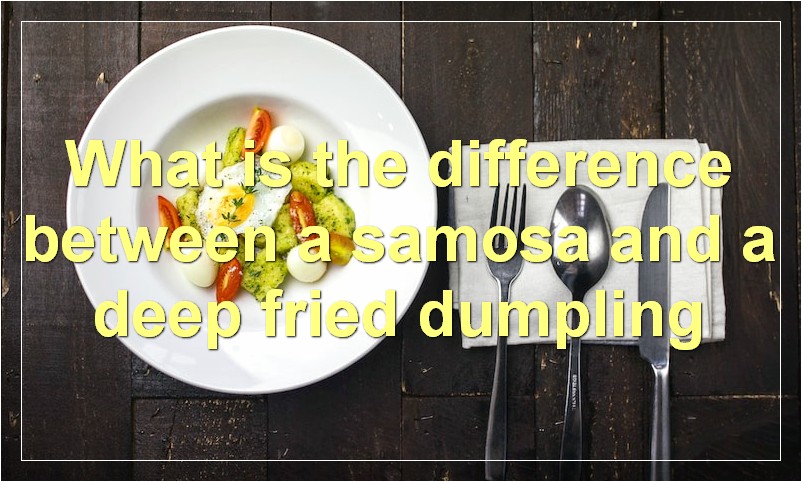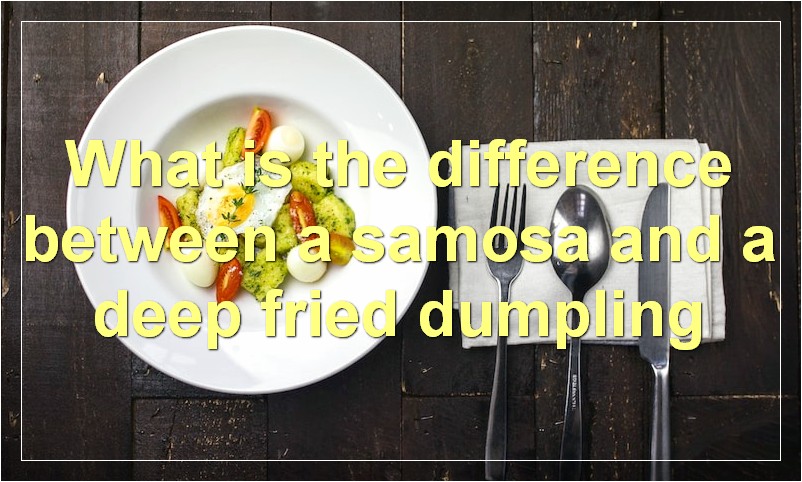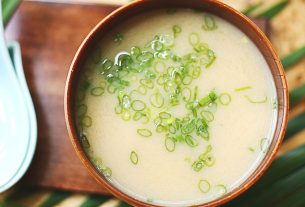A samosa is a fried or baked pastry with a savory filling, such as spiced potatoes, onions, peas, lentils, macaroni, noodles, or minced meat. A deep fried dumpling, on the other hand, is a ball of dough that is deep fried and typically served with a dipping sauce. While both are delicious, there are some key differences that make them distinct.
What is the difference between a samosa and a deep fried dumpling
A dumpling is a small, Dough-based food that can be cooked in various ways. They are commonly boiled, fried, or steamed. Dumplings can be made with various fillings, such as vegetables, meats, or sweets.
Samosas are a type of dumpling that originated in South Asia. They are typically triangular in shape and filled with potato and peas, although other fillings can be used. Samosas are usually fried, but they can also be baked or steamed.
How do you make a samosa
A samosa is a delicious fried or baked pastry that is typically filled with potato, peas, and spices. While the exact origins of the samosa are unknown, it is believed to have originated in the Middle East or Central Asia. Today, the samosa is enjoyed in many parts of the world, including India, Pakistan, Bangladesh, and Africa.
Making a samosa is not as difficult as you may think. The dough for a samosa is similar to that of a pie crust and can be made using either wheat flour or all-purpose flour. The fillings for a samosa can be very simple, such as potatoes and peas, or more complex, such as lamb or chicken. Once the dough and filling are prepared, the samosas can be fried or baked.
If you’ve never made a samosa before, don’t worry! We’ve got you covered with this step-by-step guide on how to make asamosa.
Ingredients:
1 cup all-purpose flour
1/2 teaspoon salt
1/4 cup vegetable oil
1/2 cup water
1 pound potatoes, peeled and diced
1/2 cup frozen peas
1 teaspoon garam masala
1/4 teaspoon cayenne pepper
1 tablespoon fresh ginger, minced
2 cloves garlic, minced
1/4 cup cilantro leaves, chopped
Instructions:
1) In a large bowl, combine the flour and salt. Add the oil and stir until the mixture resembles coarse crumbs. Add the water and stir until the dough comes together. Knead the dough for about 5 minutes, then cover and set aside.
2) In a large saucepan over medium heat, add the potatoes and enough water to cover. Bring to a boil and cook until the potatoes are fork-tender, about 10 minutes. Drain and add the peas, garam masala, cayenne pepper, ginger, garlic, and cilantro. Mash the mixture until it is slightly chunky.
3) To assemble the samosas, take a small ball of dough and roll it into a thin circle. Cut the circle in half and then shape each half into a cone. Fill the cone with 1-2 tablespoons of filling, then moisten the edges with water and press to seal. Repeat with remaining dough and filling.
4) Samosas can be fried or baked. To fry, heat 1-2 inches of oil in a large skillet over medium heat. Carefully add the samosas to the hot oil and fry until golden brown on all sides. Remove with a slotted spoon and drain on paper towels. Serve warm with chutney or ketchup.
5) To bake, preheat oven to 375 degrees F (190 degrees C). Place the samosas on a lightly greased baking sheet and bake for 15 minutes. Remove from oven and serve warm with chutney or ketchup
What is the most popular filling for a samosa
A samosa is a fried or baked pastry with a savory filling, such as spiced potatoes, onions, peas, lentils, ground lamb or chicken. They are often served with chutney, raita or yogurt. Samosas are popular in many countries, including India, Pakistan, Bangladesh, Nepal, Sri Lanka and East Africa.
The most popular filling for a samosa is potato and onion. Other popular fillings include peas and lamb. Samosas can be made with either a flaky pastry or a doughy pastry. The flaky pastry is more popular in India while the doughy pastry is more popular in Pakistan.
Samosas are usually fried, but they can also be baked. Baked samosas are usually healthier than fried samosas, but they are not as crispy. Samosas can be served as an appetizer or a main course.
What is your favorite filling for a samosa?
Is a samosa healthy
A samosa is a fried or baked pastry with a savory filling, such as spiced potatoes, onions, peas, lentils, ground lamb or chicken. They are often served with chutney or dipping sauce. Samosas are popular in many South Asian and Middle Eastern countries.
While samosas are often thought of as unhealthy due to their fried nature and high calorie content, they can actually be part of a healthy diet. The key is to moderate your intake and make sure you pair them with other nutrient-rich foods.
When it comes to nutrition, one samosa packs in about 18 grams of carbohydrates, 2 grams of protein and 9 grams of fat. While this may sound like a lot, keep in mind that a serving size is usually two or three samosas. So, if you’re eating just one, you’re consuming a quarter or less of the recommended serving size.
While samosas are high in carbs and fat, they do offer some nutritional benefits. For instance, they’re a good source of fiber. They also contain vitamins A and C, as well as iron and folic acid. When choosing a samosa, opt for one that has a vegetable filling over one with a meat filling. This will help boost the nutritional value.
If you are watching your weight, you may want to avoid fried foods altogether. However, if you do indulge in a friedsamosa from time to time, balance it out with healthier choices throughout the day. For example, have a piece of fruit for breakfast, a salad for lunch and grilled chicken or fish for dinner. And remember to stay hydrated by drinking plenty of water throughout the day.
How many calories are in a samosa
A samosa is a fried or baked pastry with a savory filling, such as spiced potatoes, onions, peas, lentils, macaroni, noodles, or minced meat. Samosas are often served with chutney, yogurt, or raita.
The word “samosa” can be traced back to the 13th century. It is believed to have originated in the Middle East and Central Asia. Samosas made their way to South Asia in the 14th century.
There are many different types of samosas, but they all have one thing in common: they are delicious!
So, how many calories are in a samosa? That depends on the ingredients and the size of the samosa. A small potato-filled samosa has about 100 calories. A large meat-filled samosa can have upwards of 300 calories.
If you’re watching your calorie intake, you can always go for a healthier option and make your own samosas at home. Just use whole wheat flour instead of white flour and baked instead of fried. Fill them with healthy veggies like carrots, spinach, and kale. You can even sneak in some fruit!
No matter how you make them, samosas are a delicious and fun food to eat!
What country originated the samosa
A samosa is a fried or baked pastry with a savory filling, such as spiced potatoes, onions, peas, lentils, macaroni, noodles, or minced meat. Samosas are often served with chutney, yogurt, or raita.
They are believed to have originated in the Middle East during the Abbasid Caliphate. The first recorded use of the word “samosa” can be found in a 10th-century work called Kitab al-Tabikh (The Book of Dishes), by Abu Mansur Muhammad ibn Ali ibn Nasr al-Baghdadi.
The dish later spread to South Asia, Southeast Asia, and Central Asia. In South Asia, the samosa is generally attributed to traders from Central Asia who visited India and Pakistan.
Some believe that the samosa was introduced to the Indian subcontinent by Persian-speaking Central Asian merchants. others believe that it was brought by Arab travelers.
The earliest references to the dish can be found in 9th and 10th-century Arabic cookbooks from Iraq. The recipe for samosas can also be found in 13th-century Arabic manuscripts from Egypt. By the 16th century, the dish had become popular in Persia and India.
The samosa has many regional variations. In India, there are dozens of regional varieties, including the Punjabi samosa, Bengal samosa, South Indian samosa, and Gujarati samosa.
In Pakistan, the samosa is usually triangular in shape and filled with potato curry. In Bangladesh, samosas are often oval-shaped and filled with beef or chicken.
Samosas are typically fried in vegetable oil and served hot. They can also be baked. Baked samosas are considered healthier than fried ones but are not as popular.
The word “samosa” is thought to be derived from the Persian word sanbosag, which means “triangular pastry.” The Hindi/Urdu word samsa comes from the same root. The word sanbosag is also used in Afghanistan to refer to a triangular pastry filled with meat or vegetables.
The dish is also known by other names in different parts of the world. In East Africa, they are known as sambusak; in Iran they are called sanbusak or sanbusek; in Afghanistan they are called sambusa or somsa; and in Central Asia they are called somosi or samsa.
Are there any vegetarian versions of a samosa
A samosa is a fried or baked pastry with a savory filling, such as spiced potatoes, onions, peas, lentils, ground lamb or chicken. The dough is usually made with maida flour, water and ghee or cooking oil. Samosas are often served with chutney, such as mint, tamarind or coriander-yogurt.
Vegetarian versions of a samosa typically use potato and pea fillings, although other vegetables can be used as well. The dough is usually made with maida flour, water and ghee or cooking oil. Samosas are often served with chutney, such as mint, tamarind or coriander-yogurt.
There are many recipes for vegetarian samosas available online and in cookbooks. Some recipes use pre-made pastry dough to save time, while others use homemade dough. Fillings can be adapted to personal preferences and what is available in the pantry. For example, sweet potato, tofu, cauliflower and mushrooms are all good options for the filling.
Vegetarian samosas are a delicious and easy way to enjoy Indian cuisine without meat. They can be served as an appetizer or main course, and are sure to please vegans, vegetarians and meat-eaters alike.
What are some common dipping sauces for a samosa
When it comes to dipping sauces, there are many options to choose from. Here are some of the most common dipping sauces for a samosa:
1. Mango Chutney: This sweet and tangy sauce is a popular choice for samosas. It pairs well with the savory filling of the samosa and helps to cut through the richness of the fried pastry.
2. Tamarind Chutney: Another popular option, tamarind chutney is slightly sour and pairs well with the spices in the samosa filling.
3. Yogurt: Plain yogurt or raita (a yogurt-based salad) is a common dipping sauce for samosas. The coolness of the yogurt helps to balance the heat of the spices in the samosa.
4. Mint Chutney: This refreshing sauce is made with mint, cilantro, and green chili peppers. It has a bright flavor that goes well with the richness of the samosa.
5. Ketchup: A classic condiment, ketchup is also a popular dipping sauce for samosas. Its sweetness pairs well with the savory filling of thesamosa.
Can you freeze a samosa
A samosa is a fried or baked pastry with a savory filling, such as spiced potatoes, onions, peas, lentils, ground lamb or chicken. Samosas are often served with chutney, yogurt or mint sauce.
Can you freeze a samosa?
The answer is yes! You can freeze samosas for up to 3 months. For best results, wrap each samosa in plastic wrap or aluminum foil and place in a freezer-safe bag. When ready to enjoy, simply thaw at room temperature and reheat in the oven or microwave.
Frozen samosas are the perfect make-ahead appetizer or main dish. They’re great for parties, potlucks and picnics. And they’re an easy way to have a hot, delicious meal on hand when you don’t have time to cook.
So next time you make a batch of samosas, be sure to freeze some for later!





